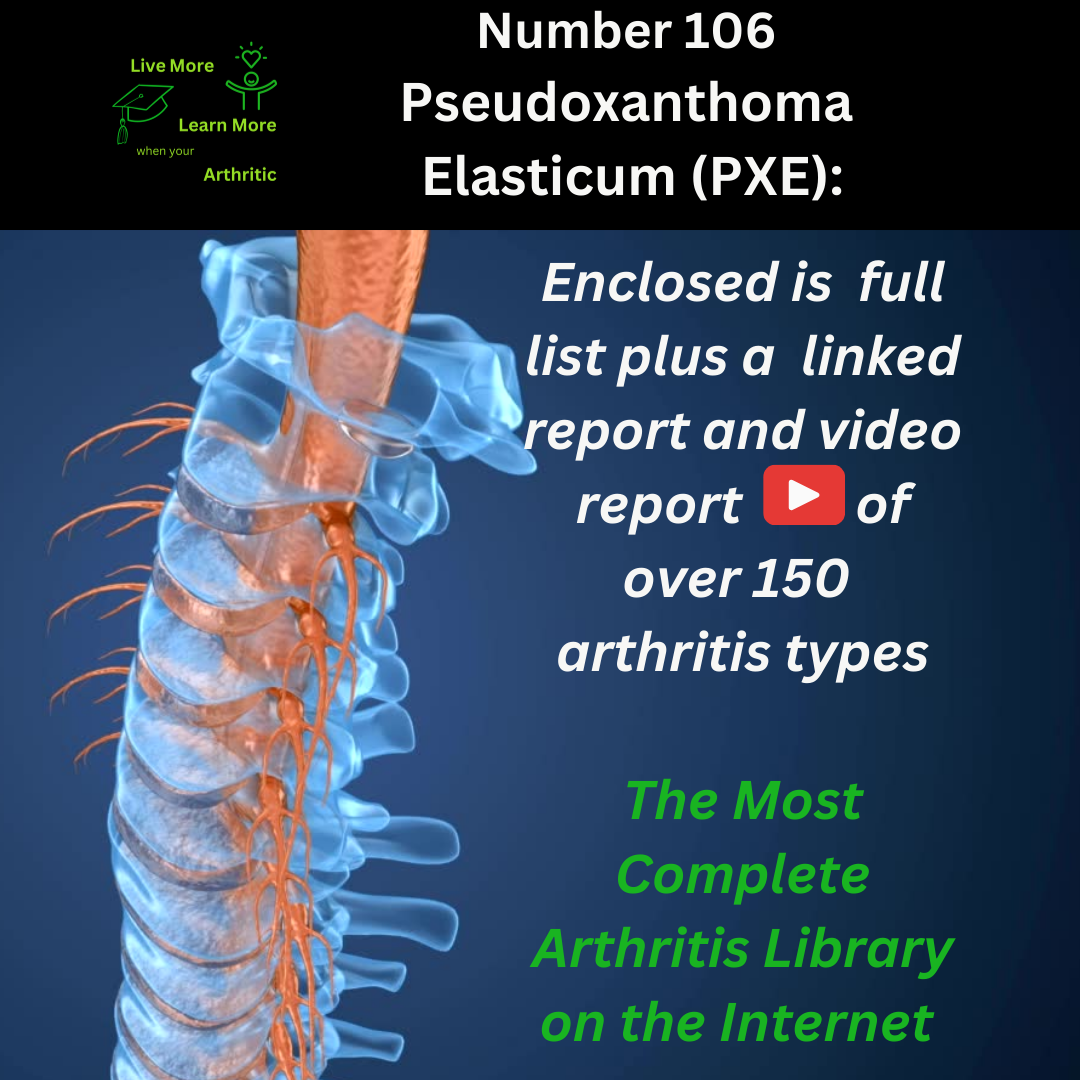
Pseudoxanthoma Elasticum (PXE): Number 106 of around 150 types of Arthritis
Unraveling the Mysteries of Pseudoxanthoma Elasticum (PXE): A Journey of Resilience
Embark on a profound exploration of pseudoxanthoma elasticum (PXE), where scientific insights intersect with personal narratives. Join us as we delve into the complexities of this condition, illuminating its effects on the body and pathways towards proactive management.
 The Body’s Blueprint: Mapping Affected Areas
The Body’s Blueprint: Mapping Affected Areas
Pseudoxanthoma elasticum primarily impacts connective tissues in the skin, eyes, and blood vessels. Elastic fibers undergo calcification, leading to skin changes, vision impairments, and cardiovascular complications.
Pursuing Possibilities: Exploring Remission and Resolution
Can PXE be remitted? Unfortunately, PXE is a progressive genetic disorder with no cure. However, early diagnosis and lifestyle modifications can mitigate symptoms and delay progression.
Deciphering the Disorder: Causes and Catalysts of PXE
What triggers this condition? PXE results from genetic mutations affecting the ABCC6 gene, disrupting normal calcium metabolism in elastic tissues. This leads to abnormal tissue mineralization.
Symptoms Unveiled: A Spectrum of Manifestations
How does PXE manifest? Symptoms include skin changes (yellowish bumps), vision problems (retinal abnormalities), and cardiovascular issues (blood vessel calcifications). Joint stiffness may occur due to calcified tendons.
The Age Angle: Onset and Ongoing Challenges
When does PXE typically manifest? Symptoms often emerge in adolescence or early adulthood. While not directly arthritis, joint stiffness and limited range of motion can impact quality of life.
Lifespan Lamentations: Navigating Longevity
Does PXE shorten lifespan? It doesn’t directly affect life expectancy. However, cardiovascular complications can pose risks. Early intervention and cardiovascular monitoring are crucial.
Autoimmune Allegories: Unveiling Immunological Intricacies
Is PXE an autoimmune disorder? No, PXE is a genetic disorder. However, immunological factors may influence disease progression and complications.
Risk Factors Revealed: Genetic Predispositions
Who’s at risk of PXE? Individuals with a family history of the disorder are predisposed. Genetic testing can confirm mutations associated with PXE.
Complications Chronicle: The Impact on Health
What complications arise from PXE? Cardiovascular issues (e.g., hypertension, stroke), vision loss (retinal detachment), and skin changes (pruritus, lesions) are common. Joint stiffness may impair mobility.
The Inflammatory Insight: Addressing Swelling and Discomfort
Is inflammation a factor in PXE? Yes, tissue calcification triggers inflammatory responses, contributing to discomfort and joint stiffness.
Tender Tendons: Exploring Pain and Mobility
Does joint tenderness accompany PXE? Yes, calcified tendons can become stiff and painful, limiting range of motion and physical activities.
Cartilage Concerns: Impact on Joint Integrity
How does PXE affect cartilage? Calcification of connective tissues can lead to joint degeneration and reduced flexibility over time.
Comorbidity Considerations: Interconnected Health Realities
Are there related conditions to watch for? PXE may coexist with cardiovascular diseases (e.g., hypertension), emphasizing the need for comprehensive health monitoring.
Embracing Proactivity: Enhancing Quality of Life
Can proactive measures improve life with PXE? Absolutely. Regular cardiovascular assessments, vision screenings, and physical therapy can optimize health and function.
Complications Unveiled: Pathways to Health Awareness
What complications arise from untreated PXE? Vision loss, cardiovascular events, chronic pain, and mobility impairments are potential outcomes requiring ongoing management.
Demographic Dimensions: Who’s Most Affected?
Does PXE affect specific demographics? It affects men and women equally, typically emerging in adolescence or early adulthood due to genetic inheritance.
 Connected Conditions: Recognizing Genetic Links
Connected Conditions: Recognizing Genetic Links
Are there interconnected genetic conditions? PXE may coexist with Ehlers-Danlos syndrome or Marfan syndrome, reflecting shared genetic vulnerabilities.
In conclusion, while PXE poses significant challenges, proactive management and holistic interventions can optimize quality of life and mitigate complications. Each step towards understanding and proactive care offers hope and resilience in the face of genetic complexities, illuminating pathways towards health restoration and renewed vitality.
